Regarding the UV EPROMs. As far as i know, Soviet electronics production only managed to get 8K done with reasonable yield. To my knowledge, no UV ROM chips has been released with 16K or more - anything of this capacity in Soviet stuff were mask ROMs or imports. For things like ZX clones Z80 and ROMs had to be imported, and that was very difficult at first. Thus in early stuff such as first ZX clones you can see either 8 of 2K UV ROMs or 2 8K UV ROMs to get the required 16K. Later importing get easier, but prices on local made components were still lower, so in early post-Soviet things like AONs you'll likely will find cloned CPU (sometimes original, though), but ROMs always will be imported. Spectrums were made in large quantities, so a mask ROM with Didactic Scalica firmware was made and used eventually, but AONs were product of individuals and small groups, so it always remained to be using UV EPROM.
327 2018-03-25 21:18:33
Re: AON, project in progress (35 replies, posted in Other Platforms)
Hardware review #1
This is the first of a few phones I got recently for the project. Seems that it has been made circa 1994. The board is the small Z80 universal one, the most recent parts on the board is from 1993. It has Rus 10 firmware installed, which has been released in late 1994. The build quality is the worst case scenario. Not a single screw or even termoglue to hold the stuff together. The speaker and display were glued to the plastic, but fell off, so when I disassembled it, everything pretty much fell apart. Yet it still in fully working condition!
Is it is in the worst shape, I decided to use it as the main testbed and modded it a bit later, fixed the stuff inside the case, added standard USB socket to power it from a modern power source (nearly all AONs use external 5V adapters with 7805 inside), and other connectors. ZIF socket to be installed yet, will show final mods eventually. For now the photos just show how it was originally.
External view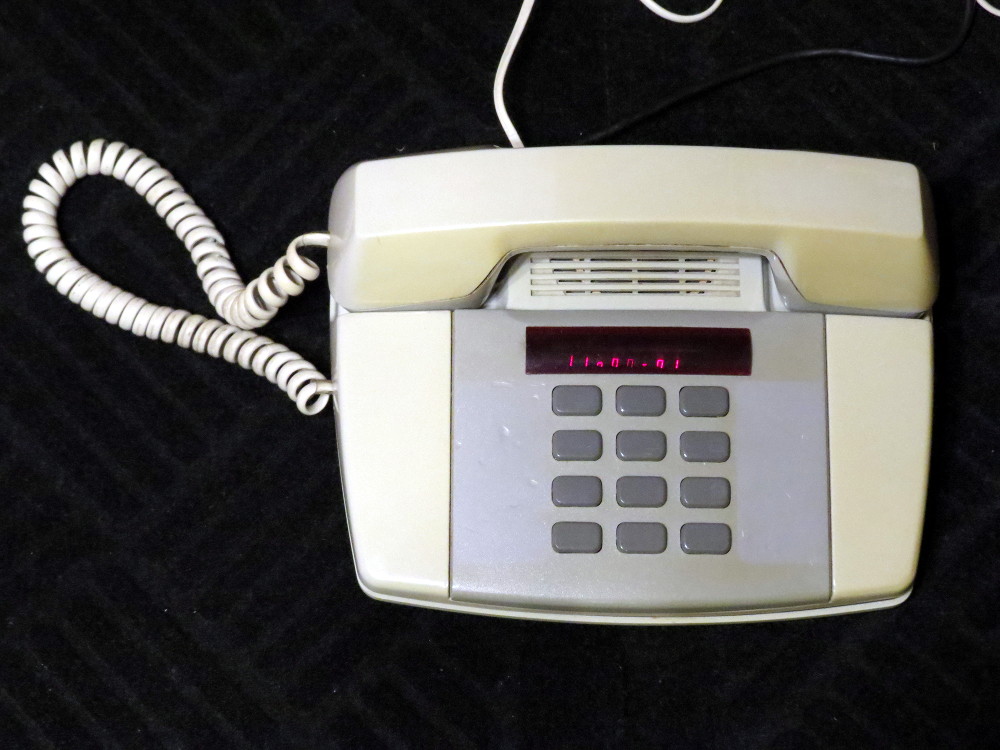
The 7-segment LED display, shows the idle mode with current time. That square between the numbers displays the current operation mode (can be other figures, this is default), so you can immediately recognize it is Rus firmware.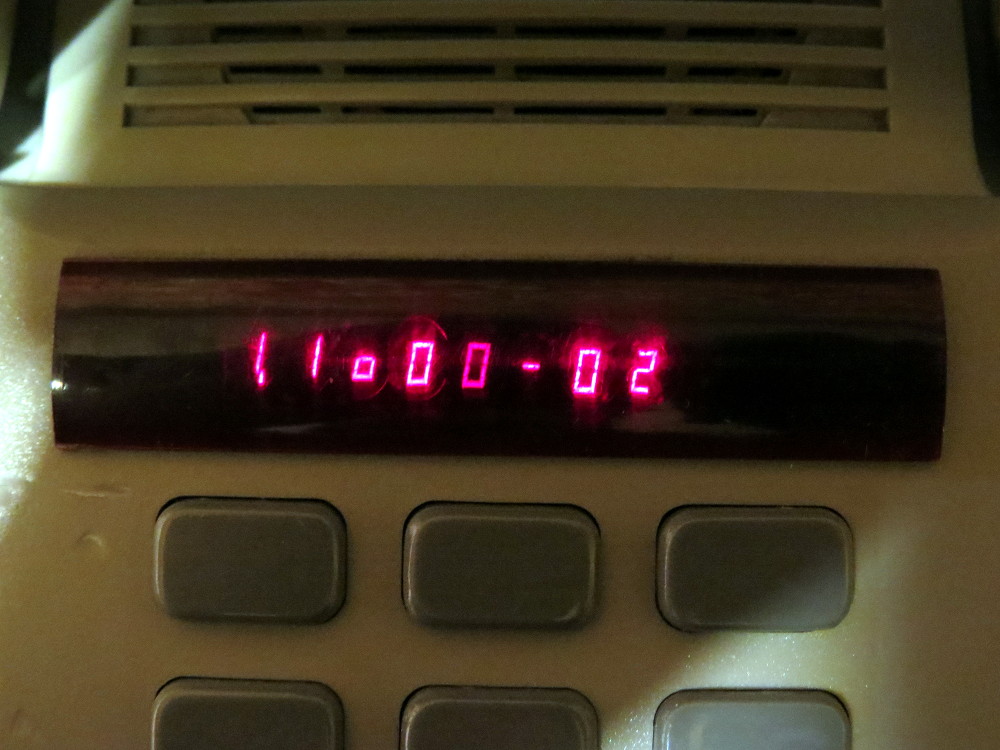
Internal view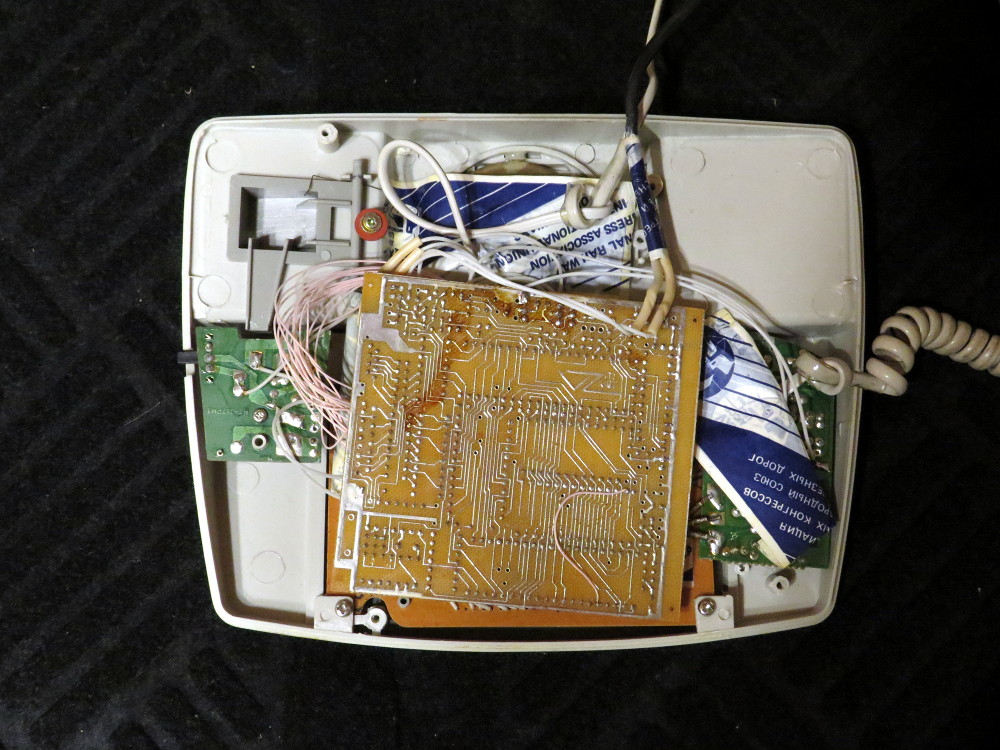
Very simple Z80 computer it is, he said.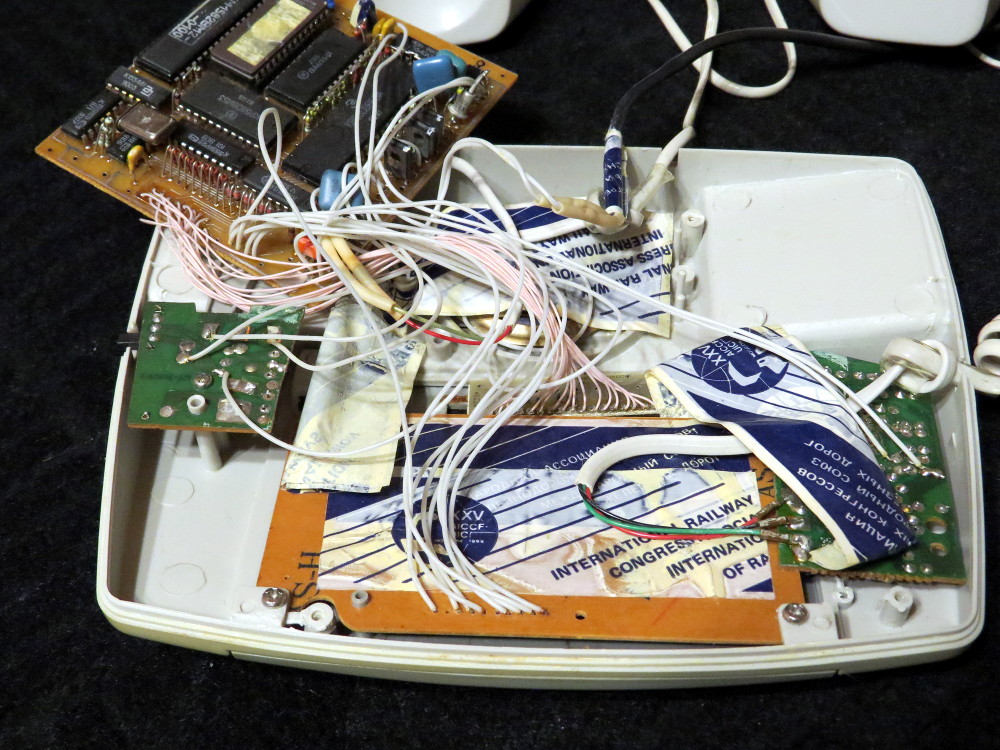
Believe or not, it works!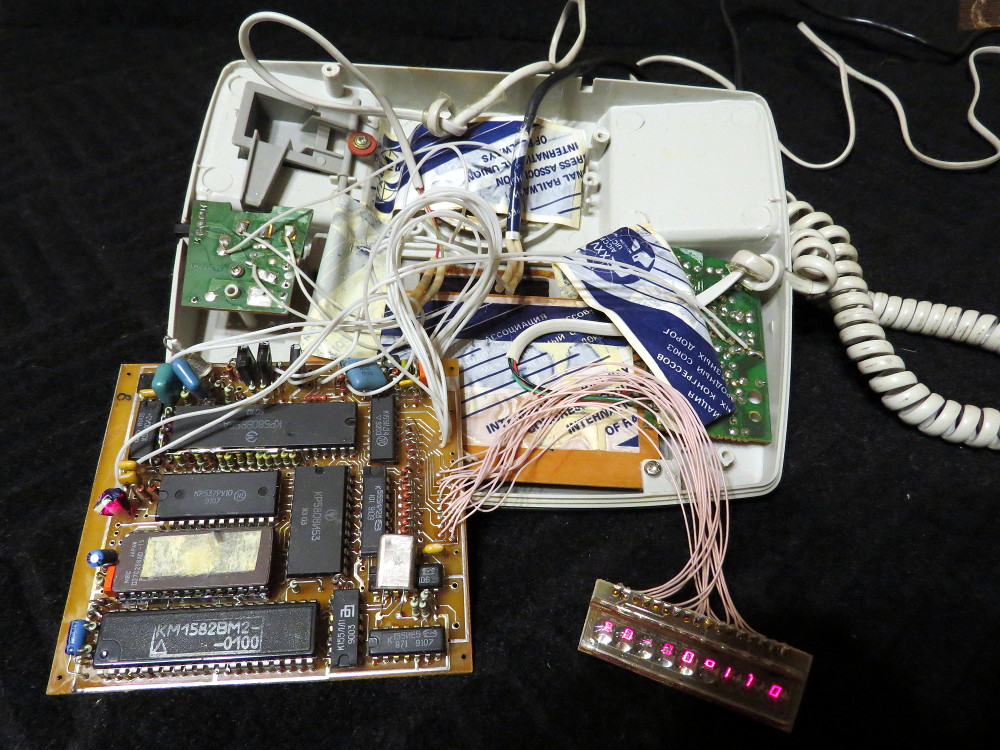
The infamous ALS318 LED display. Soviet-made, and I think it is not a clone (like most of Soviet electronics) - at least I never found the original part. The digits are extremely tiny (1.5x2.5mm), each has individual plastic lens to make them appear bigger. They're always red, no other colors.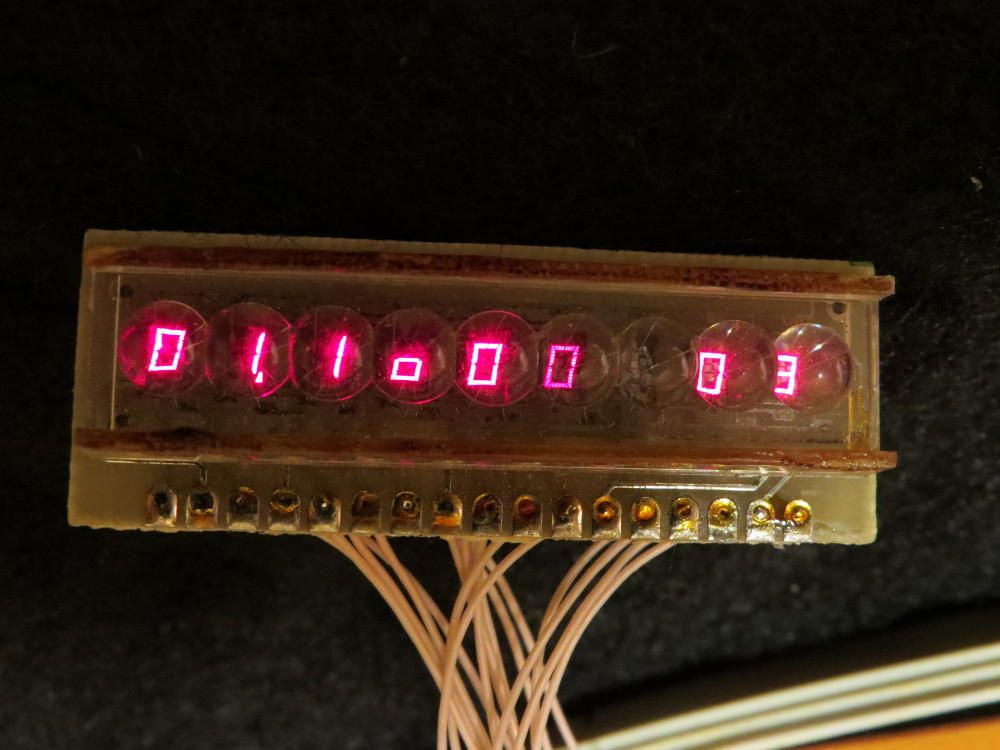
The small Z80 board, common revision. I marked main chips with their normal Western names.
Z80 on this board is a weird beast. It is a CMOS version. As far as I know, this one was actually has been made to be used in ZX clones specifically, alongside the ZX ULA clone, yet the latter never come to fruition. This way it got the 1582 number, chip series that otherwise contains all custom ULA-based ASICs, as well as -100 after the part number, which is supposed to be the firmware version (makes sense for ULAs, makes no sense for CPU). It is also marked as KM which means ceramics package, yet it is plastic. Early 1990s were lots of fun for the post-Soviet electronics industry.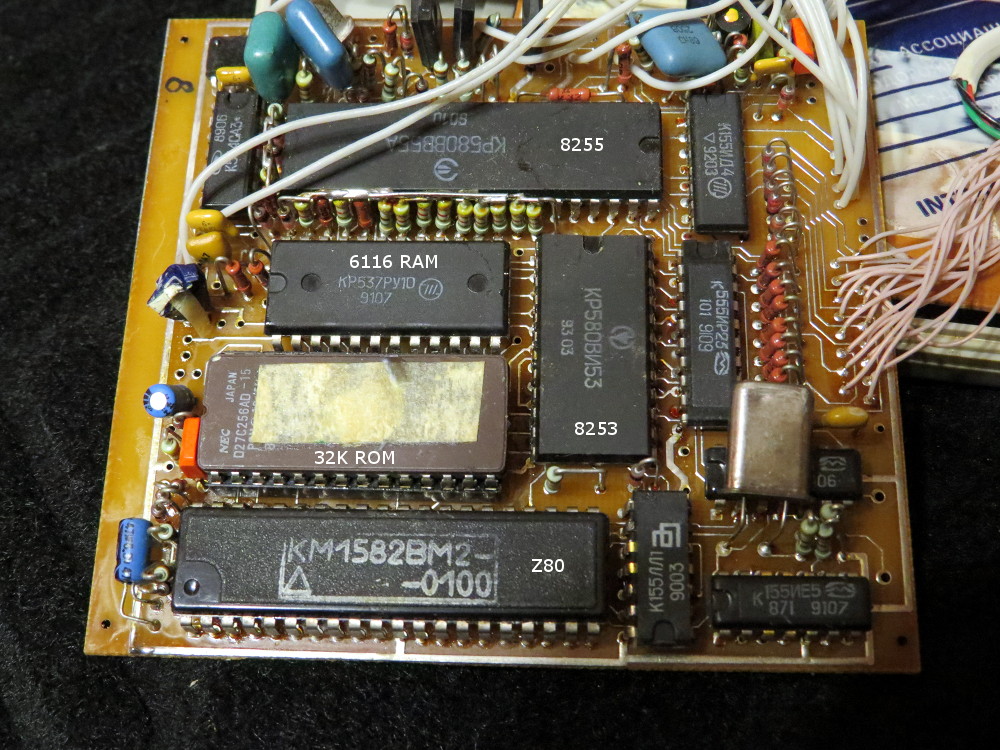
328 2018-03-24 18:26:08
Re: AON, project in progress (35 replies, posted in Other Platforms)
The sound
One interesting topic to discuss is what has been done already in regards to the sound in these devices. Music was relatively important there, used as ring and alarm tones. At first it was all monophonic 8253-driven square wave, as you could hear in the videos linked above, but later (past Z80) designs actually got polyphony and better sound.
At first the sounds range that AONs were capable of consisted of:
- Single channel sound cues and melodies
- One bit voice samples
- DTMF signals for tone dial
As far as I know, no one tried to do 1-bit synthesis for more complex music timbres and/or polyphony on the original hardware, although you can be sure a lot could be achieved there (and that's the goal of my project), especially considering hardware PWM possibility.
With the advent of 80C31 based AONs, sound started get more advanced. At first it was still one channel square wave, but with arpeggios and stuff (Rus 27). I think the CPU power of 80C31 at 10-12 MHz is roughly equivalent to Z80 at 4 MHz, maybe a bit better, but totally different architecture creates an interesting field for experiments with 1-bit synthesis.
Now, if you somehow get tired of 1-bit and want to try something different, there is more worth to mention.
Circa 2003 people from the Rus firmware devs, now turned into Rus Telecom company, managed to get 80C51-based MCU ASIC into production at Taiwan, called R100-XP. It has been designed specifically to be used in their AONs, with most of required interfaces built-in, and the most interesting feature of it was on-die AY-3-8910 replica. Phones based on this MCU, like Rus 28 Sonata, actually contained 1990s ZX Spectrum demoscene music! It sounds just like the real thing. Unfortunately, these phones are kind of rarity and hard to obtain, as they were produced and sold at decline of the AONs popularity.
There is another Rus 28 Sonata phone as well, likely with different board revision yet the same basic firmware, that besides the AY replica has 6 channel polyphonic music with more complex timbres. I don't have much info on this, but it sounds on par with the early polyphonic cell phones, and the sound is likely produced by some MIDI chip. Maybe VS1033 (was popular back then) or something.
329 2018-03-24 16:35:07
Re: AON, project in progress (35 replies, posted in Other Platforms)
The tech
Now let's see what these things got inside.
The 8080-based design is a rarity, because the CPU required three power voltages, was relatively slow and complex, so it was quickly replaced with a Z80 design. Thus I won't go into specifics with that one. Then there was an early Z80-based design without 8253, it is even more obscure than 8080 designs.
The most common Z80-based design has:
- Z80 running at 4 MHz. No wait states, NMI not used.
- 8253 running at 1 MHz, one channel for INT, another for sound output.
- 8255 to control display and poll buttons.
- 9-digit 7-segment LED driven by a parallel register and 8255.
- 2K SRAM, could be 8K. The 2K is most commonly installed, direct 8K installation used to be done to expand contact lists capacity. Schematics is designed for 8K, no banking. RAM can be battery backed, usually there is a capacitor large enough to keep the contents of the RAM if the device gets powered off for a minute.
- Up to 64K ROM, the usual size is 32K that fits as a whole into the address space. In case with 64K extra 32K is banked using an 8255 output line.
- Up to 7x8 key matrix, at least 12 standard keys connected, depends on phone model.
- All I/O devices conviniently mapped to the Z80 I/O space with short addressing, no memory mapped devices there.
- It even has port to start/stop tape recorder, to be used as an answering machine.
Thinking of it, it is quite a 1-bit power house. Slightly faster than ZX Spectrum, no wait states at all, fast access to all I/O, 8253 use is very similar to the one found in IBM XT, can be used for PWM and stuff. You also can control output directly with additional output bit, as well as with gate control. There is enough outputs to make stereo, or multiple outputs with analog mixing. There is a comparator that is used to sample the phone line to read Caller ID codes (a series of sine waves, frequency encoded), which is very similar to the tape interface.
The main challenges there is very limited RAM, although with 8K it gets better, and techically you can put 32K there using extra 8255 lines to control paging, and the limited user interface capabilities, especially in regards of the display. But it is also more fun then.
Interesting thing to note is that as there is no TV display and its specific timings, you can easily downclock or overclock the device just by changing the crystal oscillator. Of course it would break the original phone firmware functionality (needs to run at specific clock to detect and generate phone signals), but totally no problems for new custom firmware. The limit is the just the frequency that main chips can tolerate. Normally there is original Z80A or a CMOS clone installed that works on the standard 4 MHz and can tolerate a little bit more.
The 80C31 designs is relatively common, but not nearly as much as Z80 one. There is a number of designs. I'm not really want to work with these at the moment, so I won't get far into specs, but in short it is:
- 80C31 at 10/12 MHz
- Up to 64K ROM, usually 32K
- 2K or 8K SRAM
- No 8253 or 8255, just a few latches for I/O lines
Besides the full blown phones, there were Caller ID add-ones. They're include the same variety of the hardware and more, i.e. Z80 and 80C31 designs. The firmware is usually very similar, kind of cut-down versions of the bigger brothers, but controls are much simpler, usually just five buttons. These can be interesting too, but for now I leave them out.
Should be also mentioned that there were other more modern designs, not listed above, PIC based for example. These mostly were done as add-on devices.
Just for reference, Z80 design schematics:
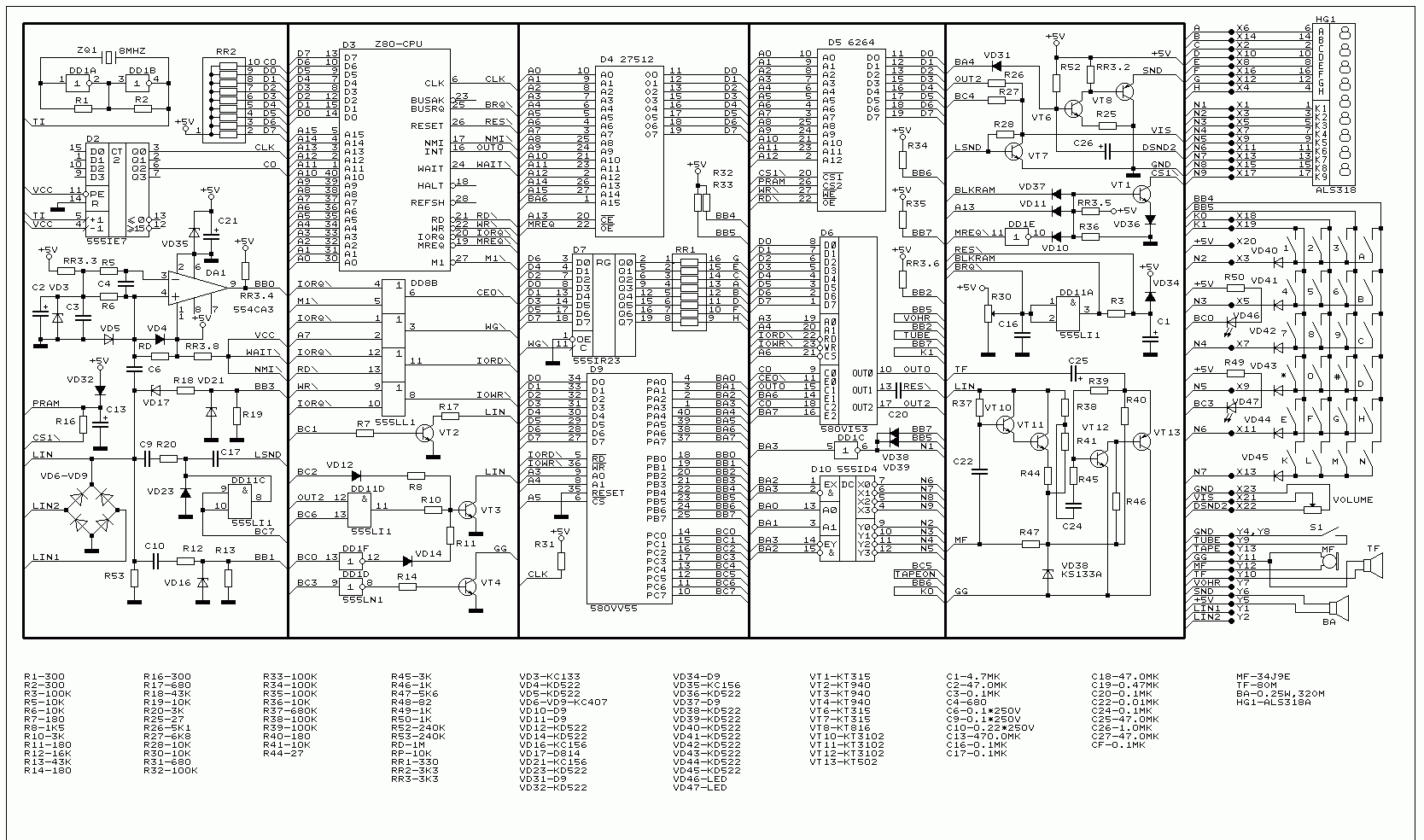
330 2018-03-24 13:11:14
Re: AON, project in progress (35 replies, posted in Other Platforms)
Nostalgic things
There is also a personal retro computing nostalgic factor that may feel kind of weird for you, but still. Back in the 1980s electronics and computer related stuff in USSR mostly were both rarity and luxury. People weren't yet much familiar to home computers, electronic games, video recorders, TVs with remote, FM radios, and such, it all was a technological novelty coming directly from foreign movies and sci-fi books. In the very late 80s these things started to get imported and appear on the black market under insane prices, and with the fall of USSR all kinds of imported and local built electronics flooded the country - you probably have heard of Spectrum clones and Dendy, as few examples of this.
For us kids of the time all kinds of previously unseen technology were extremely fascinating. Casio watches with melodies, Chinese sound effect keychains, Game&Watch clones, Brick Game (Tetris electronic game) - everything caught our curiosity and attention. We loved to explore its capabilities, disassemble it to see what is inside, and so on. AONs became part of this too. Besides the ever-fascinating clever use of the 7-segment LED display that used to produce cryptic text messages (Ln Hold), one thing we appreciated a lot was the sound. Right from the excerpt from the Mikhail Glinka's 'Glory' that played during power up sequence of the Rus firmware (originally a choir piece that sings 'Glory to Russia', akin to the firmware name that is short for Russia), to a few dozens of built-in ring tones and alarm melodies, which were versions of classical and popular music. We listened and loved to recognize the famous songs in this basic square tone computer renditions. As you may guess, with Z80 and 8253 on board it was all monophonic 1-bit square wave music, albeit nicely programmed. One missing historic piece that alongside the Speccy and NES music got many of us here interested in computer music in general.
A bit later the Rus firmware was upgraded with speech synthesis - male then female voice that could say the incoming call phone number, or current time, and some other things, constructed of pre-recorded words, like old talking clocks did. It also could be used to know who was calling when you're not at home, you could call to your own number and use tone dial phone (or portable DTMF beeper device even!) to enter password and hear the speech synthesizer talking you through the call list. It was very impressive at every level, and voice quality was pretty nice for the time. Think of how voice clips were impressive in early computer games.
Close friend of mine at the time (mid 1990s) was involved into production of AONs, his father ran that private business, so he helped with soldering and assembling a ton of them. Thanks to this I learned a lot about the internals, and was also fixing and upgrading AONs for my friends time to time. So it provided me with some early digital electronics skills.
I first got the idea to use the hardware to produce some sounds back in 2014, when I was thinking of creating a simple 1-bit DIY synth and was considering to use Z80. I thought I still owned a pair of old AONs that used to belong to my childhood friends in 90s, and did some research, planning, and programming of basic emulator to make further development more comfortable, with plans to create a simple 1-bit programmable drum machine out of it at first, and something more interesing eventually. Unfortunately, later it turned out both of these somehow went to trash during major cleanup at house at some point in 2013, and I havent't found another one. Then other stuff got priority, so I had to postpone the idea. Until now!
You can listen to some of the monophonic music here: https://www.youtube.com/watch?v=A0IKdIRfoFw. This is Rus-25 on the 80C31-based board, but the same music was in the Z80 version as well (Rus firmware went to 23rd revision there, then moved to the new HW).
You can hear the speech synthesiser in this boring and shaky video, as well as see some of the interface. Again some of 80C31-based versions. https://www.youtube.com/watch?v=SOHX96BbhCk
331 2018-03-24 09:53:34
Topic: AON, project in progress (35 replies, posted in Other Platforms)
Please note. This is a long-term project of mine that has low priority and may come to fruition in some future (or not). I don't know when I will have time to work on it, but once I do, I will post updates and write ups in this thread. I just thought it would be cool to share the inception and development process of the idea with you, hardcode 1-bit entusiasts, as it may have more interest to you than the actual project, and maybe could provide you with ideas and inspire to do some unusual and bizzare stuff too.
Some history
AON (Avtomaticheskij Opredelitel Nomera, roughly translates as Auto Caller ID) is a product of early spontaneous small business that exploded in Russia just along the fall of the Soviet Union (early 1990s). It is a land line telephone device, or an add-on device to a normal telephone, with the killer feature being the built-in Caller ID function, plus things like contact list, alarm clock, calculator, speech synthesizer, answering machine, and such. Kind of early smart phone, as it was seen back then, long before any cell phones. Caller ID service was implemented by the land line provider infrastructure to be used by special government services such as police, but was totally not seen in consumer devices before. Even push buttons phone was something of luxury high tech at the time, with most of phones around the country being rotary dial ones from 1960s. Tone dial support was almost absent at the time, and remains uncommon in Russia even today (pulse dial in most places).
AON devices got huge popularity - at some point like it was in like every 2-3nd house. About a hundred of versions were designed, developed, and produced by thousands of individuals at their homes - electronic engineers who lost their jobs or income at the difficult times of USSR dissolution, but now available opportunity of private business. It was kind of blend of DIY and business, very similar to that happened with ZX clones in Russia that first were constructed and produced by enthusiasts as well. Some of those individuals later formed legit small business as a company, and kept production active up until 2004. Since late 90s, phone line operator wasn't happy by the increased load to their infrastructure that previously wasn't even considered as a paid option. They tried to make it such, with very limited success at first - no one wanted to pay, yet it was impossible to block it separately from the main services until a major update in the land line infrastructure that happened in 2000s. Land phone popularity went down greatly with major spread of cell phones by then, so the era of AONs has come to end.
Being mostly private one-person operated business, the devices were'n developed as an actual commercial product, like a phone with its own exterior design and casing. It was rather a PCB that was built into some existing push button phone. At very first it was targeted to the only relatively obtainable model in USSR produced by the Latvian VEF company (VEF-TA-12), so the board was designed to fit the tricky outline of the phone shell, complete with LED display and buttons placements. Later, with the flood of imported push button cheap phones after 1991, Z80 board was redesigned to be smaller and universal, allowing to embed it into many different cases. Clones of the 90s Panasonic office phone design were among the most popular ones, but countless other kinds were available as well, as each individual produced AONs with whatever parts he could obtain.
Now we're getting to the most interesting part. All AONs inside is a mere single board 8-bit computer with very basic architecture, kind of a crude MCU.
At first it was an Intel 8080 clone based design, it had a few versions of the firmware with pretty limited functionality. Very quickly it got changed to Z80 (imported, later cloned), with 8255 and 8253 on the board. Boards were mostly made with Soviet-produced parts (clones of 74xx, Intel, and Zilog chips), including the only available back then 7-segment LED display with very tiny digits - you immediately recognize its look if you seen it once. Build quality of the devices of this period was a total disaster - hot glue, adhesive tape, and almost no screws all over the place - yet it still works even 25 years later. Z80 version remained the most popular design, with two main kinds of the PCB (large VEF-specific and 9x10 cm universal one) produced. Dozens of firmware versions (Alfa, Fortuna, Julia, Lira, Selena, Vega, and the incredibly popular Rus), as well as dozens of revisions has been made for this design, with different functionality and user interface. These could be interchanged with very minor modifications to the board, if any, so it makes kind of standardized platform. The simplest firmware was just 8K ROM, most advanced ones became as large as 64K.
In later years a new Intel 80C31-based hardware has been designed to improve functionality and cost even further. Cheap Chinese electronic parts became available at this point, so they were used more often, including larger and better LED displays, but still mostly done with chips in DIP packaging, so it remained easy to modify. These aren't as common as Z80 ones, though, but very interesting nevertheless.
Today these old phones relatively easy to obtain in Russia, about $5-15 used, as they no longer have much use. Some enthusiasts were using them as an MCU to control some stuff such as machinery, or a smart house, or a car computer, as it is cheap and very easy to hack and modify. A small self-contained device with 12 or more push buttons, 9-digit 7-segment LED display, Z80 or 80C31 inside, capable to produce audio through few outputs, capable to sample analog input (phone line), usually has ROM in a socket - you know where I'm coming from.
The original VEF-TA-12 based design. Display put to the place where the paper note originally located, so it looks like it is actually designed to be like that.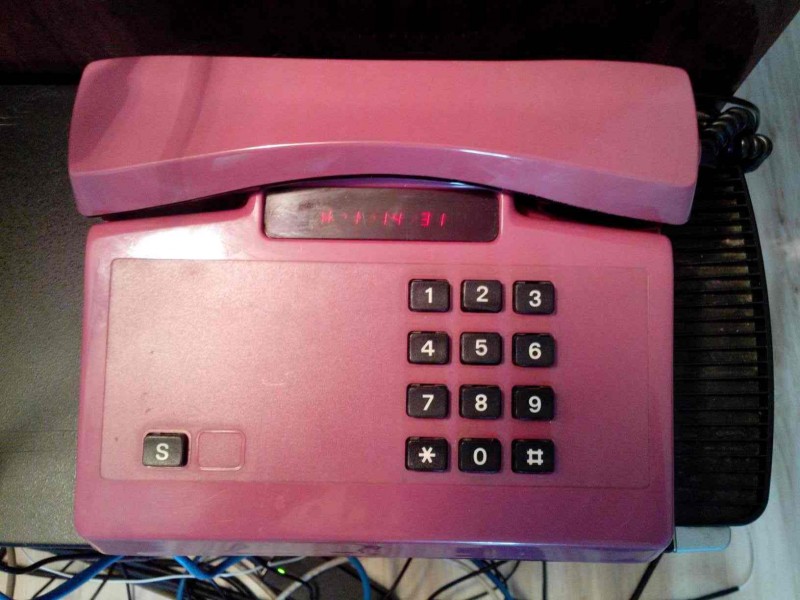
The most common Panasonic clone design. Also common for the later 80C31 devices. White was the most common, but there were other colors, and different number of extra buttons (shortcuts to different features).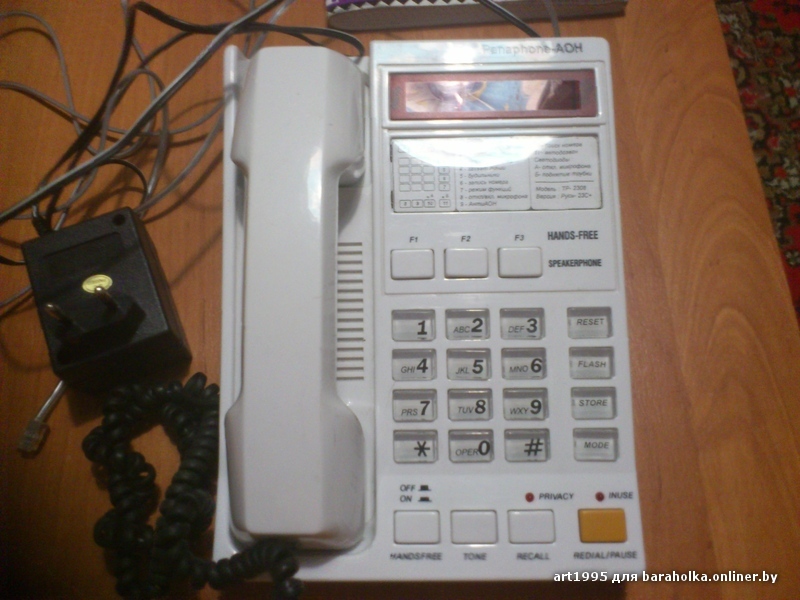
Random chinese phone based design, lots of such stuff.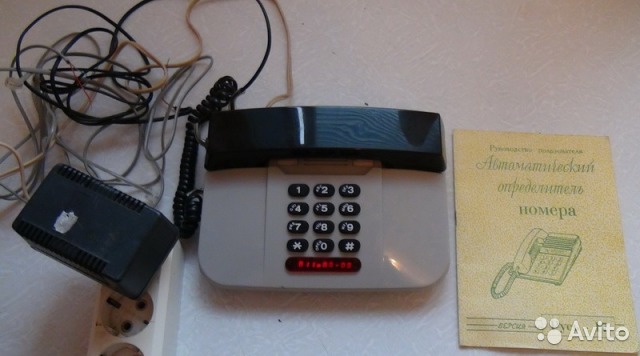
332 2018-03-09 11:26:10
Re: In-game (during gameplay) music (20 replies, posted in Sinclair)
It will work, but basically it just inverts the idea of playing sound in spare CPU time that is left of a frame - the second apporoach I described above. Just different technical implementation.
Engines like Special FX work better with this approach, because of very short pins they're generating.
333 2018-02-06 20:48:10
Topic: Compo: Multimatograf 2018 (5 replies, posted in Sinclair)
Another upcoming russian demoparty, Multimatograf 2018. Vologda, Russia, April 29-30. Remote entries allowed.
There is united 8-bit music compo, ZX beeper is allowed, as well as any sound chips and music made with 8-bit computers in general (some non-ZX 1-bit stuff may slip into).
334 2018-02-03 15:57:34
Re: next gen engine ideas (135 replies, posted in Sinclair)
Seen interesting comment on youtube recently where a guy explained his understanding of how Wham and other interleaving engines works. It is interesting way to look at the things. He considers that logic of such engines is:
- when both channels has output 0, engine outputs 0 to speaker, thus output weight is 0
- when both channels has output 1, engine outputs 1 to speaker, thus output weight is 1
- when channels output is not the same, engine outputs sequence of 1 and 0 at it maximum possible sample rate, which makes kind of output weight 0.5
335 2018-01-19 14:58:07
Re: new engine: wtbeep (21 replies, posted in Sinclair)
Yes, I thought so as well, but wasn't sure 100% either.
I also suspected the exx fix affecting that (like third channel counter value gets lost between rows), but didn't found obvious errors with it.
336 2018-01-19 14:05:30
Re: new engine: wtbeep (21 replies, posted in Sinclair)
No, I wasn't able to figure out clicks. You can hear it just by using the third channel, any notes, it is quite apparent.
337 2018-01-18 12:20:12
Re: Compo: Di Halt 2018 Lite (15 replies, posted in Sinclair)
Thanks, guys. Here is a little video that shows how the floppy song is made: https://www.youtube.com/watch?v=A6gGCLnFvPo
338 2018-01-08 15:29:31
Re: Compo: Di Halt 2018 Lite (15 replies, posted in Sinclair)
Yes, please test it in 0.29, as there were many fixes to many engines, and report if there are issues.
339 2018-01-08 02:48:02
Re: Compo: Di Halt 2018 Lite (15 replies, posted in Sinclair)
Wow, utz, that was Squat?! I thought it is one of your awesome engines.
Don't worry, AtariTufty, I earned my first ever last place this time too (in MP3), woohoo!
340 2018-01-07 00:58:14
Re: Compo: Di Halt 2018 Lite (15 replies, posted in Sinclair)
The results:
1. 7.88 D.S.F. by utz ^ irrlicht project
2. 7.55 Fase Cuatro by Shiru
3. 6.95 Headbanger by Shiru
4. 6.50 The Last Midnight by Tufty ^ 1-bit forum
Congratulations, utz!
341 2018-01-06 22:29:16
Re: Compo: Di Halt 2018 Lite (15 replies, posted in Sinclair)
I heard in the party's video stream that organizers were happy with quality of beeper entries this and past years, and only wish there were more entries.
342 2018-01-06 07:48:20
Re: 1tracker v0.47 (166 replies, posted in Sinclair)
New year, new update, v0.29.
Added Squeeker, Squeeker Plus, Vibra, nanobeep, Lyndon Sharp's engine from Super Dragon (Wham with sampled drums), Music Studio, ZX-3.
343 2018-01-03 20:31:26
Re: Compo: Di Halt 2018 Lite (15 replies, posted in Sinclair)
Just a day left before the deadline. Three entries so far. You still have a chance!
344 2018-01-03 05:03:13
Re: Questions about three engines. Could you identify them ? (14 replies, posted in Sinclair)
Interestingly, Super Dragon Slayer has not one, but two songs on the title screen, alternating after each game over.
The most fun part, as far as I understand the code, is that drum track pretty much independent from the tone channels, it is much shorter than the tone track, looped, and there is row counter that delays when the drum track starts to play relatively to the tone channels.
345 2017-12-31 14:27:17
Re: 1tracker v0.47 (166 replies, posted in Sinclair)
Added xtone too. Because with beeper engines we always have just one less than enough.
346 2017-12-30 22:07:42
Re: 1tracker v0.47 (166 replies, posted in Sinclair)
Actually, just thought to promote 0.28 to release. With 28 engines!
It got Quiet mode (for slower engines, you can enter notes without making sounds and related slowdowns), minor fixes, and more engines. Besides wtbeep, there is AntEater, povver, and quattropic now.
If you downloaded WIP build, redownload it, there were changes, including fixes in wtbeep.
347 2017-12-30 00:52:57
Re: 1tracker v0.47 (166 replies, posted in Sinclair)
Added wtbeep engine, added loop support to Pytha. No real version update, just these two engines and 0.28 WIP build (don't remember if I changed anything important).
348 2017-12-30 00:51:50
Re: new engine: wtbeep (21 replies, posted in Sinclair)
Added this engine to 1tracker.
Minor issues. It seems that you messed up exx' in the pattern reading a bit, so you can't just have an empty row, or skip first or first and second channels. Edited the code to make it work. Also, there is loud clicks in the third channel after notes, unlike the first two.
349 2017-12-25 10:32:44
Re: PCB for Beeper (and other chiptunes) musics (35 replies, posted in Other Platforms)
I see there is this project: https://playground.arduino.cc/Code/ArduZ80
Don't know if it's possible to use the other beeper engines on it!It's also possible to drive a real z80 from arduino: http://baltazarstudios.com/arduino-zilog-z80/
I looked into this before. Unfortunately, ArduZ80 is not usable at all. It is incomplete, misses hundreds of opcodes, even some widely used documented ones, does not have any time tracking (very important for beeper uses), and is written in C, so likely not fast enough even in such incomplete form.
Hooking up actual Z80 does not make much sense to the original purpose - a beeper sound card. Z80 emulation on Arduino was considered to make device more accessible, reduce number of components and eliminate need of having EPROM burner. Otherwise you can just design the device with actual Z80, it just adds a few more logic chips (~10 chips total), and you need to program the boot ROM.
350 2017-12-17 21:52:28
Re: PCB for Beeper (and other chiptunes) musics (35 replies, posted in Other Platforms)
Still hope we'll do a full blown Z80 emulation with AY format player on Arduino eventually.